Treblinka Concentration Camp: History & Overview
Treblinka was designed as a Nazi extermination camp in occupied Poland during World War II. The camp, constructed as part of Operation Reinhard, operated between July 1942 and October 1943. Approximately 850,000 men, women, and children were murdered, including more than 800,000 Jews.
Before its liberation by the Allies, the retreating German army liquidated the camp and destroyed whatever evidence remained of the atrocities committed within its fences. For many decades, the only evidence of the horrors that took place at Treblinka came from testimonies of Nazi SS-men stationed there as well as a few Jewish survivors who were willing to share their stories, but in 2012 forensic archaeologists uncovered previously hidden mass graves at the site that help prove its term as an extermination camp.
Samuel Willenberg, the last of only 67 survivors of the Treblinka extermination camp, passed away in Israel on February 21, 2016, at the age of 93. Willenberg was brought to Treblinka in 1942 at age 19 and survived because he was strong and told the guards that he was a builder. Allegedly, he was the only individual on his transport that was not sent to the gas chambers immediately upon arrival. He escaped Treblinka on August 2, 1943, along with 300 others, and survived the massive SS search that recaptured 200 escapees despite being shot in the leg. Following his escape, Willenberg returned to Warsaw, Poland and, after finding his father living in hiding outside of the ghetto, he joined the underground resistance and participated in the Warsaw Uprising.
What Was Treblinka?
Approaching the Treblinka Camp
The Entrance to the Treblinka
Treblinka Memorial Stones
Stone Sculptures at Treblinka
Symbolic Cemetery at Treblinka
Stone Honoring Janusz Korczak
Warsaw Stone
Uncovered Mass Graves Site
What was Treblinka?
For the first 20 to 25 years after World War II, the survivors of the Holocaust mostly kept silent about their horrendous experiences in the concentration camps. In those years, the only Nazi concentration camp names familiar to most Americans were Dachau, Buchenwald, and Bergen-Belsen, the places shown in the newsreels in movie theaters following their liberation by American and British troops. Who could ever forget the sight of the naked, emaciated bodies being shoved into mass graves with a bulldozer at Bergen-Belsen? Or Margaret Bourke-White's shocking photographs of the survivors of Buchenwald?
Back then, few people in America had ever heard of Treblinka, a camp hidden in the remote forests of northeastern Poland, along the western border of the Bialystok province. Most Americans believed, up until the mid-1970s, that the majority of the 6 million Jews, who were victims of the Holocaust, had died in the gas chambers at the Dachau camp near Munich, Germany. The only camp mentioned in the 1970s movie “Judgment at Nuremberg” was Dachau.
It is known that Dachau and Buchenwald, although horrible places where many people died, were concentration camps (Konzentrationslager), not extermination centers (Vernichtungslager). Bergen-Belsen was called an internment camp for prisoner exchange (Aufenthaltslager) and later became a sick camp (Krankenlager) where concentration camp prisoners who were no longer able to work were sent.
There were six extermination centers, all of them in Poland, including Treblinka. The other extermination camps were at Belzec, Sobibor, Chelmno, Majdanek and Auschwitz-Birkenau, all in Russian-liberated Poland. The last two also functioned as forced labor camps (Zwangsarbeitslager) and were still operational when liberated by Russian soldiers towards the end of the war in 1944 and early 1945. Before the Russians arrived, the Germans had already liquidated the camps at Treblinka, Belzec, Sobibor, and Chelmno, and there was no remaining evidence of the Nazi atrocities.
An information pamphlet available at the entrance to the former campsite at Treblinka says, “In a relatively short time of its existence the camp took a total of over 800,000 victims of Jews from Poland, Austria, Belgium, Czechoslovakia, France, Greece, Yugoslavia, Germany, and the Soviet Union.”
From Warsaw, the route to Treblinka starts with the crossing of the Vistula, then a turn onto Highway 18 northeast towards Bialystok, the only large town in the Bialystok province, which is the most remote northeast corner of Poland. It is in the Bialystok province that bison still roam, and one can see the last remaining primeval forest and wetlands on the European continent. This area could genuinely be called the “Wild East” of Poland.
Treblinka is near the Bug River, which, during World War II, formed the border between the Nazi-occupied General Government of Poland and the zone occupied by the Russians from September 1939 until the German invasion of Russia in June 1941.
Highway 18 is a two-lane concrete road with pedestrian paths on each side. There is heavy traffic of trucks from Belarus (Byelorussia or White Russia) and Estonia traveling west into Poland; traffic is slowed down by local Polish farmers driving wagons pulled by tractors or by a lone horse. The terrain is flat with farm land on each side of the road but not a fence in sight. Then the road goes through mile after mile of dense forest. During the war, these woods were full of Polish and Jewish partisans, who hid there along with escaped Russian Prisoners of War, and fought the Nazis by blowing up bridges and train tracks or placing land mines to kill columns of German soldiers.
About 14 miles from Treblinka, the route turns southeast off Highway 18. This new road is a one-lane blacktop with no space on the sides for pedestrians. The road gets progressively worse until the final leg of the journey is pockmarked with potholes.
The Treblinka camp got its name from the tiny village of Treblinka, the closest town to Malkinia railroad junction, from where trains carrying thousands of Jews crammed into freight cars were shunted onto a sidetrack which the Nazis extended to the extermination camp. However, the closest inhabited place on the road to the camp is the equally tiny hamlet of Poniatowa. As it nears the camp, the road becomes a one-lane blacktop, badly in need of repair.
During the Nazi occupation of Poland, there was a forced labor camp at Poniatowa; in November 1943, the Jewish prisoners were shot after prison revolts, and mass escapes at the Treblinka and Sobibor camps alarmed the Nazis.
The village of Treblinka is now almost deserted, and the buildings are far more dilapidated than those in Poniatowa. Some of its rural dwellings are so humble that you would not suspect that people still live there if it were not for the lace curtains which are always hung in the windows of these cottages.
Approaching the Treblinka Camp
As you get near the village of Treblinka, there is a line of beautiful chestnut trees alongside the road on the right. You see older men walking along the road, carrying bundles of sticks on their backs. Farm families dig potatoes and burn dried potato vines in the fields. Occasionally, you see a stork's nest on a roof near the chimney, or a large ant hill at the edge of a forest, surrounded by a tiny log fence for protection. There are old wooden Catholic churches and white cottages with thatched roofs along the road. Telephone poles are topped with glass insulators, the kind you see for sale in antique stores in America. The farther you travel down this road, the farther you seem to go back in time.
Near Malkinia Junction, the road now has ancient concrete barriers and quaint old railroad crossing signs to prevent cars from leaving the road. From this junction, a branch line runs south from the Ostbahn (Eastern Railroad line) to the village of Treblinka.
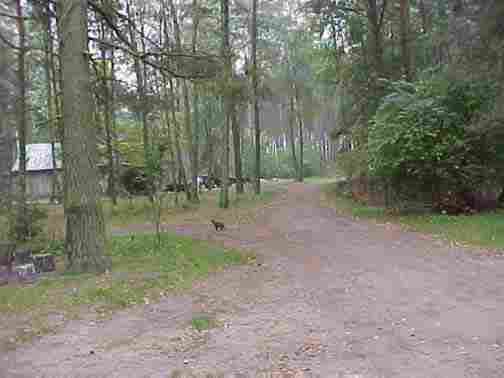 Entrance to Treblinka camp, from inside the camp |
Finally, you get to a narrow archway over the road to keep vehicles larger than 2.5 tons from proceeding beyond this point. Before you get to the camp, you must cross a one-lane railroad bridge formerly used by trains and cars but now used only by cars and pedestrians. According to Martin Gilbert in his book Holocaust Journey, this bridge was rebuilt sometime after 1959, after it was destroyed during World War II.
The bridge's surface is made of wood, and the train tracks are not level, which would cause any train using the bridge to list to one side. The tracks in Germany and Poland were then, and still are today, a different width than the tracks across the eastern border of the Bialystok District in what used to be the Soviet Union and is now the country of Byelorussia, formerly called White Russia. According to my tour guide, today, trains from Germany or Poland must stop at the Bialystok eastern border and change to wider wheels that can run on the tracks in Russia. In 1941, the invading German army needed to extend the Polish gauge tracks into Russia as they advanced. The poor condition of the roads in Poland and Russia hampered the advancing German troops when their vehicles would become mired in three feet of mud. The main railroad line into Russia passed through the Bialystok province and was about two miles from Treblinka.
After the joint conquest of Poland by the Germans and the Russians in September 1939, the river Bug (pronounced Boog) became the border between the German section and the Russian section of occupied Poland; then the Nazis invaded the Soviet Union in June 1941 and conquered the strip of eastern Poland that the Russians formerly occupied. Treblinka was in the former Russian section, but by 1942 it was occupied by the Nazis, who were then in a position to put their plan to exterminate the Jews into effect. The other two Operation Reinhard extermination camps (Sobibor and Belzec) were also located along the Bug river border, south of Treblinka.
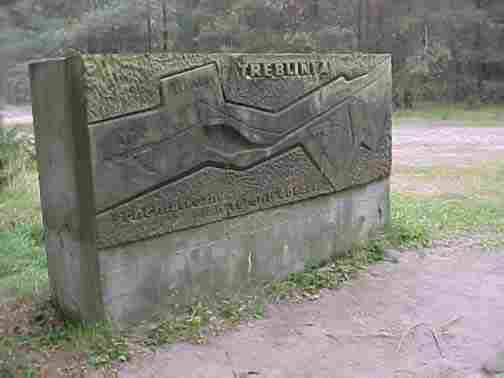 Memorial stone at the entrance to Treblinka |
Hardly more than a creek, the Bug is shallow enough in some places so that one can wade across it, and according to historian Martin Gilbert, some refugees, from both sides did wade across. The movie “Europa, Europa” has a scene in which Jewish refugees are shown walking toward the Russian sector, trying to escape the Nazis in September 1939 by crossing the Bug river on rafts.
The pictures above show the archway, the bridge, and the river, taken on the return trip from Treblinka.
The Entrance to the Treblinka Extermination Camp
When you finally arrive at the entrance to the site of the former Treblinka extermination camp, you are on what looks like an old logging road, which goes through another dense forest. If you had wandered into this area by mistake, you might think that you had just entered a campground in a national forest. Everything is quiet and serene, with only the sound of a few birds.
The caretaker's house is on the right as you enter, and there is a small wooden building with a sign on it that says Bistro. After I visited the camp, I stopped there for a cup of tea, but the place was closed. Beyond the Bistro is a narrow parking lot and a small building where you can buy postcards or a three-page pamphlet printed in several languages.
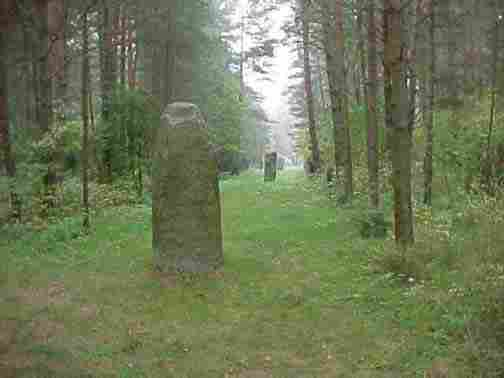 A line of stones marks the boundary line of Treblinka |
There is a covered arcade area open to the elements in front of the building, where huge blowups of several famous Holocaust pictures are hung, along with a poster with some information about Janusz Korczak, a Jewish director of an orphanage, who accompanied a group of orphans to the Treblinka camp, and died along with them.
Treblinka Memorial Stones
According to a pamphlet from the camp tourist center, “The extermination camp in Treblinka was built in the middle of 1942 near the already existing labor camp. It was surrounded by a fence and rows of barbed wire along which there were watchtowers with machine guns every ten meters. The main part of the camp constituted (sic) two buildings in which there were 13 gas chambers altogether. Two thousand people could be put to death at a time in them. Death by suffocation with fumes came after 10 - 15 minutes. First, the bodies of the victims were buried and later were cremated on big grates out of doors. The ashes were mixed witch (sic) sand and buried in one spot.”
According to Martin Gilbert’s book Holocaust Journey, the gas chambers at Treblinka utilized carbon monoxide from diesel engines. Many writers say that these diesel engines were obtained from captured Russian submarines, but according to the Nizkor Project, they were large 500 BHP engines from captured Soviet T-34 tanks. At the Nuremberg trial of the Nazi war criminals, the American government charged that the Jews were murdered at Treblinka in “steam chambers,” not gas chambers.
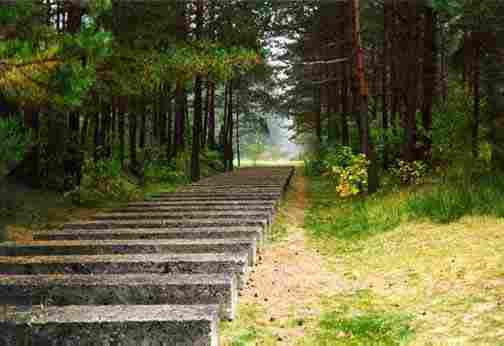 Stones recreate railroad ties for the tracks. |
The pamphlet continues with this information: “Killing took place with great speed. The whole process of killing the people, starting from thier (sic) arrival at the camp railroad till removing the corpses from the gas chambers, lasted about 2 hours. Treblinka was known among the Nazis as an example of good organization of a death camp. It was a real extermination centre.”
There is a large memorial stone at the entrance to the cobblestone path up to the virtual cemetery. On the stone is a map showing the gravel pit in the center with the labor camp to the left and the extermination camp to the right. (On an accurate map, the gravel pit and labor camp are located south of the extermination camp.)
Two stones are placed at an angle to form a gate into the former camp, and in the foreground, six memorial stones are set close together, located just beyond the stone with the map. Each of the six stones is inscribed in a different language, including Hebrew, English, and Polish. The inscription says that the camp was in operation from July 1942 to August 1943 and that 800,000 Jews were killed there during that time. It also mentions the Aug. 2, 1943 uprising, calling it the “armed revolt which was crashed (sic) in blood by the Nazi hangmen.” This uprising, along with those at Sobibor and Warsaw, motivated the Nazis to liquidate the Jews of Lublin and Poniatowa in November 1943.
The pamphlet says, “After the riot the camp was being slowly liquidated and in November of 1943 it was not existing already.” By this time, the Germans were losing the war on the Russian front and were in retreat. The Treblinka camp was completely dismantled and destroyed when it was liquidated. Among the few survivors were those who escaped during the uprising and joined the partisans in the forests.
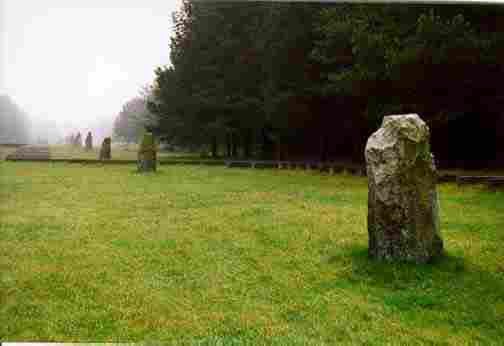 Large stones mark railroad ties inside the camp. |
Looking toward the east, on the left side of the cobblestone path as you enter, there is a line of stone markers that delineate the original northern border of the camp. It is so quiet here that the only sound is your footsteps on the cobblestone path.
Stone Sculptures at Treblinka
According to Jewish historian Martin Gilbert, the Treblinka camp was one of the three Operation Reinhard camps organized by Odilo Globocnik in 1942, after the assassination of Reinhard Heydrich in Prague, to carry out the Nazi plan for the systematic extermination of the Jews. Reinhard Heydrich was the man who led the conference on January 20, 1942, at Wannsee, a suburb of Berlin, where the “Final Solution” for Europe's 11 million Jews was planned. The protocols from the conference used the expression “transportation to the East” as a euphemism to mean the genocidal killing of all the European Jews. The other two Operation Reinhard camps, Sobibor and Belzec, were also located on Poland's eastern border, to the south of Treblinka. No " selections " were made at the Operation Reinhard camps, nor at Chelmno. All three Operation Reinhard camps were on major railroad lines from Poland into Russia.
At this point in the war, the Nazis had penetrated deep inside the Soviet Union after first taking the lands in eastern Poland, which the Russians had conquered in Sept. 1939. Treblinka was located in the area of Poland, which the Soviet Union had occupied from September 1939 until the German invasion of Russia on June 22, 1941.
The railroad tracks go straight to Malkinia Junction from Warsaw and then branch off to Treblinka.
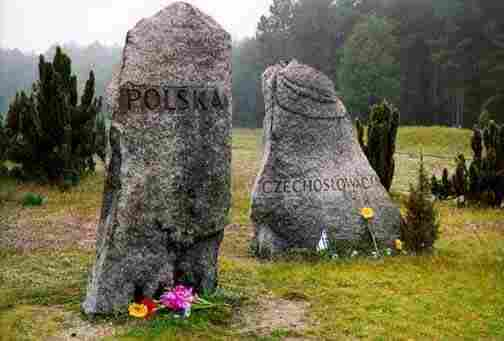 Stones commemorate the victims from Poland & Czechoslovakia |
In 1942 new railroad tracks were built by the Nazis, extending from the village of Treblinka into the extermination camp. At the camp, a storehouse was “disguised as a train station,” according to the pamphlet available at the memorial site.
After you pass through the two stones set at an angle to form an entrance gate into the area where the Treblinka camp once stood, you come upon a massive stone sculpture designed to represent the railroad ties on which the tracks were laid on the spur line that the Germans built from Treblinka into the camp. The tracks begin in the wooded area outside the camp boundary line and then turn sharply to the left (eastward) into the camp.
Nearby is the end of the railroad spur line with a stone platform to the left. When the camp was in operation, there was an actual train platform in this spot, and behind it, the storehouse, disguised as a train depot, contained the clothing and other items the victims had brought with them. Here lies a line of stones representing the ten different countries, including Greece, Czechoslovakia, Poland, Bulgaria, and others, from which the Jews were transported by train to be exterminated here in this remote, God-forsaken spot in the forest.
Symbolic Cemetery at Treblinka
Just south of the recreated stone train platform, and in front of you as you look southward into the camp with the platform on the left, is the location of the “burial pits for those who died during transportation,” according to the camp pamphlet.
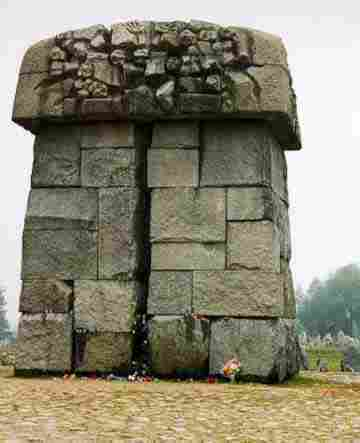 Front of the stone monument at Treblinka symbolic graveyard |
According to the pamphlet, east of the burial pits was an “execution site (disguised as a hospital).” Farther east and halfway up the gentle slope to where the symbolic graveyard now stands, there were “3 old gas chambers,” and a short distance to the north, “10 new gas chambers” were built. According to my tour guide, the first gas chambers used carbon monoxide, but later some gas chambers were built, disguised to look like showers, and used the insecticide known as Zyklon B for gassing.
The “cremation pyres” were a short distance up the slope to the east of the gas chambers. None of the three Operation Reinhard extermination camps on the Polish border had a crematorium for burning the bodies of the dead. Of the other five extermination camps in operation during the same period (Chelmno, Sobibor, Belzec, Majdanek, and Auschwitz-Birkenau), only Auschwitz-Birkenau and Majdanek, which also functioned as forced labor camps, had crematoriums.
Inside the camp lie stones commemorating the Jewish victims from Poland and Czechoslovakia. There are ten such stones with names of countries on them. According to Martin Gilbert in his book Holocaust Journey, there were 13,000 Jews deported here from the Greek provinces of Macedonia and Thrace, which were then occupied by Bulgaria, so their stone says “Bulgaria.” (Bulgaria was an ally of Nazi Germany, along with Rumania, Hungary, Croatia, Slovakia, Finland, Italy, Austria, Lithuania, Estonia, and Latvia.) There is another stone for the 43,000 Greek Jews who were brought here. At the base of the stones, visitors have placed votive candles in metal cans, fresh-cut flowers, and tiny flags of Israel.
According to the camp pamphlet, a large granite memorial stone, designed to resemble a Jewish tombstone, was built between 1959 and 1963. It is located approximately on the spot where the gas chambers stood, according to the tour guide. A Menorah sits at the top of the tombstone. The large crack down the middle of the stone is part of the design. Surrounding the huge monument are some of the 1,700 small stones representing the villages and towns from whence came the 800,000 victims of this Nazi barbarity.
Stone Honoring Janusz Korczak
Located on a knoll at the top of a gentle slope on the site of the former Treblinka extermination camp is a large circular area with 1,700 stones of various sizes and colors set into concrete, representing a symbolic cemetery. According to a pamphlet about the camp, “The great monument in Treblinka is a homage of the Polish people to those ashes lie under the concrete plates of the symbolic cemetery. It is one of the most tragic monuments of martyrdom in Poland.”
My tour guide confirmed that the ashes of the 800,000 people who died here were placed in this area and are now hidden underneath the symbolic cemetery and by the grass and tiny flowers which cover the spot. The map in the camp pamphlet does not specify the exact location where the ashes were buried.
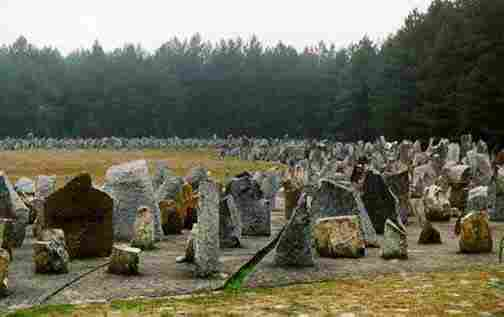 1,700 stones set in concrete in a circle at the top of Treblinka |
The tour guide pointed out one of the 1,700 symbolic stones representing the city of Kielce in central Poland, where 42 Jews were killed by a mob of Polish citizens in a pogrom on July 4, 1946, long after the Nazi occupation had ended. Today Kielce is a modern industrial city with a population of 210,000, located between Warsaw and Krakow. In 1939, the Jewish population was around 25,000, although, until the early 1800s, Jews were barred from living in the city. The 1946 pogrom was the last in Poland; after that most of the 300,000 Polish Holocaust survivors fled the country.
There is also a stone for Janusz Korczak, the only person to have an individual stone in the symbolic cemetery. Korczak was a pseudonym for Dr. Henryk Goldzmit. He was a teacher and a social worker who ran an orphanage in Warsaw. He also did a weekly radio show for children and wrote a series of children's books in which the central character was a boy king named King Matt. In July 1942, he turned down the opportunity to escape from the ghetto and accompanied his orphans to Treblinka, where he was murdered along with them. According to the U.S. Holocaust Museum, Korczak marched with his 192 orphans to the Umschlagplatz with one child carrying the flag of King Matt with the Zionist flag on the other side.
Another stone represents the cremation pit where, according to the camp pamphlet, bodies were burned on “grates.” The brochure calls “melted basalt” set on a “concrete fundamental plate.” Four round containers where “eternal flames” can be lit on special occasions. The map in the camp pamphlet shows two cremation pyres just east of the ten new gas chambers. The bodies which had been previously buried were dug up and cremated on the orders of Heinrich Himmler after he visited the camp in 1943, according to Martin Gilbert.
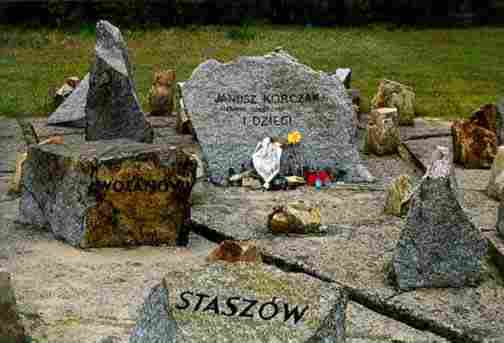 |
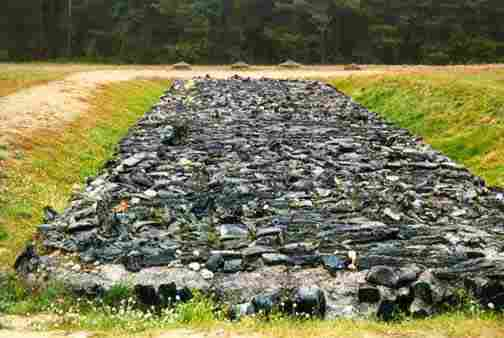 |
Warsaw Stone
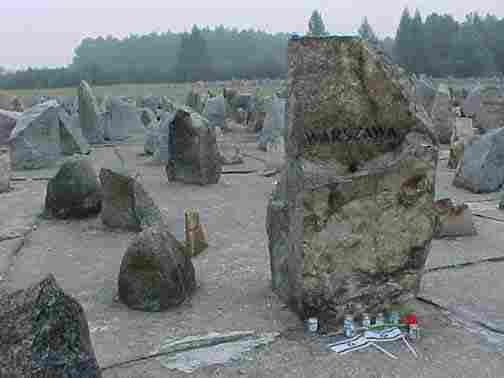 Symbolic grave stone honors victims from (Warsaw) |
The largest stone at the symbolic cemetery is the one for Warsaw, from where the largest number of Jews were transported to Treblinka. According to historian Martin Gilbert, 265,000 Jews from Warsaw were deported to Treblinka. In 1940 the Jewish population of Warsaw and the surrounding area, about 400,000 people, were crowded into a walled ghetto, then sent to Treblinka and other camps. According to my tour guide, there are today around 4,000 Jews living in Warsaw, but only 500 go to the Synagogue regularly.
The first picture below shows the large stone dedicated to the victims from Warszawa, the Polish name for the city that Americans know as Warsaw. Note the two flags of Israel and the small metal cans holding votive candles left by recent visitors. This stone is the first one you see, right in front of the prominent memorial tombstone.
The second picture shows more stones under a majestic tree in the back portion of the symbolic cemetery, behind the simulated cremation pit. According to the map in the camp pamphlet, the area behind the symbolic cremation pit was where the bodies were buried before they were dug up and cremated.
The third picture is a close-up of the stones under the tree. As you can see, very few of the stones have names of the towns they represent. According to my tour guide, many relatives of those who died here come to the symbolic cemetery and are disappointed that their village is not named on any of the stones.
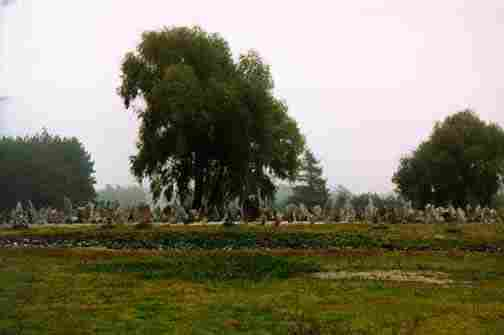 |
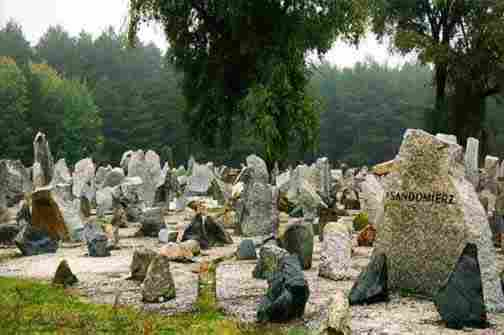 |
Uncovered Mass Graves Site
In January 2012, British forensic archaeologist Caroline Sturdy Colls uncovered mass graves in the Treblinka camp that were previously hidden underground. Using special, ground-penetrating radar equipment and other advanced technology so as not to cause complications with Jewish law, which forbids disturbing burial sites, Colls and her team managed to uncover graves at the camp where it is widely held that the Nazis murdered more than 850,000 people, the vast majority Jews.
Since the liberation of the Treblinka by the Allies, Holocaust deniers have harped on the fact that no evidence of the exterminations supposedly carried out at the camp has been found. This new evidence will help formally disprove those who still believe that the Treblinka camp was nothing more than a transit camp that moved Jews from Poland to other concentration camps across Europe.
Only 67 people survived Treblinka.
The research and findings from this study were presented as part of the documentary, 'The Hidden Graves of the Holocaust.'
Sources: Scrap Book Pages.
Jerusalem Post (January 19, 2012).
Wesley Pruden, “The last living witnesses; they wore the yellow star and remember the Nazi terror,” Washington Times, (December 12, 2013).
“Last Treblinka death camp survivor Samuel Willenberg dies,” BBC, (February 20, 2016).


